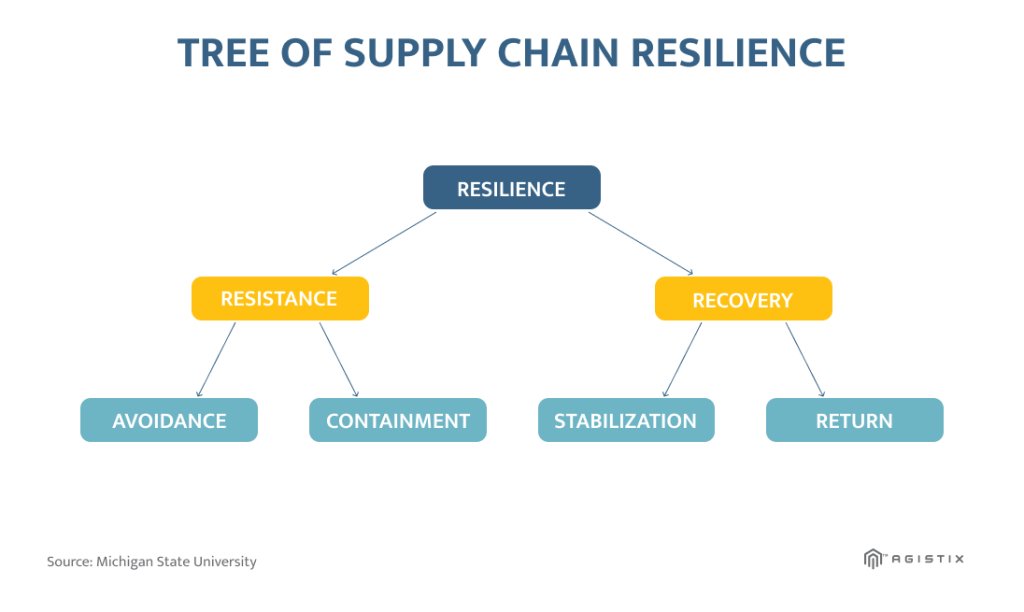June 4, 2024 - 9 minutes read

Building a Resilient & Proactive Supply Chain: A Roadmap to Automation
The last decade was a redefining period for global supply chains in many ways. The rapid acceleration of e-commerce, exemplified by Amazon’s dominance, coupled with unforeseen events like the COVID-19 pandemic, the 2023 war in Ukraine, and extreme weather events disrupting global shipping. This has made supply chain resilience a top priority for businesses around the world.
These factors undoubtedly amplified existing issues within the industry, including capacity shortages, increasing complexity due to globalization, and economic pressures. With so many fluctuating considerations, companies must develop strategies to insulate their supply chains from unexpected challenges. Flexibility is now a critical focus for supply chain executives.
A 2023 Gartner survey identified three key motivations among supply chain leaders: pioneering new forms of engagement, optimizing for resilience, and scaling performance to enable technology delivery “any place and any time.” This reflects a growing recognition that supply chains must evolve to be more agile, adaptable, and technology-driven to proactively mitigate risks in an increasingly complex and unpredictable world.
Supply chain resilience: What you should know
A resilient supply chain isn’t built overnight. It requires a multidisciplinary approach—from diversifying supplier and carrier networks to investing in advanced technology and promoting a culture of collaboration.
What is supply chain resilience?
In a nutshell, supply chain resilience definition is the ability to not just survive disruptions, but to adapt, recover, and even thrive in the face of them. Resilience in supply chains involves overcoming challenges while utilizing existing resources to minimize disruption.
Resistance to emerging issues shows a supply chain’s capacity to minimize the damage of disruption, and recovery is its capacity to quickly return to regular processes after an unprecedented event.
Resilient supply chain: Key benefits
A resilient supply chain is a dynamic shield that protects your company from unforeseen shocks. By actively identifying and addressing weaknesses, and adjusting to unforeseen obstacles, it becomes a driver of growth and profitability.
The benefits of supply chain resilience are numerous and extend to every business facet, including:
- Reduced risk: Better equipped to handle disruptions, minimizing operational and financial impact.
- Enhanced agility: Quicker recovery and ability to capitalize on new opportunities.
- Cost reduction: Avoidance of costly production delays and disruptions.
- Competitive advantage: Differentiator in a saturated market, attracting and retaining customers.

The role of the supply chain risk management strategy
There are numerous successful corporations with strong supply chains, but recent events have shown that even large and seemingly equipped businesses are susceptible to frustrating and costly consequences in the wake of disruption. While no organization is immune to risks, some companies are able to recover faster and experience less damage than others. The difference typically lies in their risk management strategies: companies with robust and well-thought-out risk management strategies are better able to navigate difficulties. Proactively managing possible risks and achieving end-to-end visibility enables the supply chain resilience model, a key differentiator for successful businesses today.
The problem is that many executives de-prioritize risk management or implement half-hearted measures simply to tick the right boxes. Real action is often only taken when something catastrophic has already happened. Until recently, resilient or agile supply chains weren’t considered much at all, because massive disruption was rare.
Unfortunately, focusing only on major disruptions is a rather short-sighted approach. Risks present themselves in many forms, including natural disasters, capacity shortages, production issues, logistics bottlenecks (like the 2023 Suez Canal blockage), and shallow relationships with suppliers. Many other factors can interfere with daily operations, so building a flexible supply chain resilience strategy for a number of difficult scenarios will lead to a proactive supply chain solution.
To implement best practices for risk management, a business should answer the following:
- What threats does your company currently face?
- What outcomes would those risks produce?
- What’s the likelihood of these risks happening?
- If the risk is likely to occur, is a plan of avoidance in place?
- How can we improve supply chain resilience this year?
A strategy for building a resilient and agile supply chain
Another challenge with building an agile supply chain is understanding that changes don’t happen overnight and that they don’t have to disrupt the business flow. This approach is careful yet effective, involving slowly detecting weak points and steadily working towards preventing any possible risks. Below are some key supply chain resilience examples.
Proactive – identifying risks before they occur
Identifying possible risks is the first step in the roadmap to a proactive supply chain. Often, executives underestimate how many ‘unpredictable’ risks are actually lying just beneath the surface. Analyzing former disruptions within a supply chain can help distinguish weak spots and repeatable patterns — for instance, whether there is a consistent failure with inventory, inbound shipments, or last-mile delivery. But large disruptions are not the only ones businesses can gain valuable experience from. Small mistakes occur daily and should be addressed to reinforce resiliency; however, even proactive supply chains find it impossible to estimate risks and possible outcomes if they lack an adequate level of visibility.
A connected network of suppliers and carriers
Trusted relationships with vendors, suppliers, carriers, and logistics providers are fundamental to a successful risk management strategy. Open communication and shared values are essential, but what truly fosters strong, long-lasting partnerships is visibility throughout.
When all parties have clear insights into transactions and shipment statuses, it breeds trust and confidence. This transparency allows for proactive problem-solving, as potential issues can be identified and addressed early on. Moreover, once all stakeholders can access and amend shipment data live, it destroys information silos, reduces manual errors, and promotes faster decision-making.
Mitigating supply chain risk through diversification
Over-reliance on a single supplier or carrier can expose businesses to significant operational and financial risk. Supply chain diversification is a strategic approach to minimizing these vulnerabilities by establishing a broader network of partners.
Supplier Diversification
A diverse supplier base offers more than just risk mitigation–it’s a proactive strategy for achieving cost efficiency and enhancing product quality. By engaging multiple suppliers, businesses gain negotiating leverage, leading to more favorable pricing, payment terms, and service level agreements. Additionally, a wider pool of suppliers opens doors to a greater variety of products and services, potentially fostering innovation and driving product quality improvements.
Carrier/Transportation Provider Diversification
Similarly, having multiple carriers at your disposal allows for quick adaptation in the face of capacity constraints, service disruptions, or unexpected price increases. This flexibility ensures the continuous flow of goods, upholding on-time delivery commitments and maintaining customer satisfaction.
Diversifying both supplier and carrier relationships is key to creating a more adaptable and robust supply chain ecosystem. This approach reduces dependency on single points of failure, minimizes the impact of disruptions, and enhances your ability to navigate unforeseen challenges.
Supply chain visibility & digitalization
Having a transparent and well-integrated supply chain is the main factor enabling true resilience and agility. Visibility and simultaneous control over processes allow issues to be detected early, giving companies the ability to react quickly to emerging challenges and prevent them from becoming calamitous.
Supply chain visibility and digitalization are the key driving forces for a proactive and resilient supply chain.
Data centralization involves collecting and consolidating data from various sources, including suppliers, manufacturers, warehouses, transportation providers, and retailers, into a single repository. This consolidated view provides a comprehensive picture of the entire supply chain, enabling real-time monitoring of inventory levels, shipment statuses, and production schedules.
Data standardization is equally vital. It ensures that data from different sources is consistent, accurate, and easily comparable, meaning businesses can analyze data effectively, identify trends and patterns, and gain actionable insights to drive continuous improvement.
Digital tools and technologies automate data collection, streamline communication, and facilitate real-time collaboration across the supply chain. Processes can be broken down to a granular level, aiding the detection and prevention of risks at the early stages. This level of visibility enables businesses to proactively identify potential disruptions, such as delays in shipments, quality issues with raw materials, or unexpected demand fluctuations.
Data availability and analytics
Having access to real-time, accurate data is not enough; businesses must also have the tools and capabilities to analyze this data and extract meaningful insights.
Data analytics helps companies identify trends, patterns, and correlations in their supply chain data that would otherwise go unnoticed. Advanced analytics tools, powered by AI and machine learning, can further enhance the value of data. They can help quickly identify anomalies, predict disruptions, and recommend optimal solutions. As such, machine learning algorithms can analyze vast amounts of data to identify patterns that indicate a potential supplier failure, allowing businesses to take proactive measures to mitigate the risk.
Data visualization tools simplify the complexity of data, making it more accessible and easier to understand. Through the use of charts, graphs, and maps, companies can rapidly comprehend essential insights and effectively relay this information to stakeholders.
Proactive and agile supply chain with automation software
Data centralization and robust, integrated digital infrastructure are the drivers of end-to-end visibility and agility. Eventually, resilience can be achieved with a high level of supply chain transparency and connectivity. Investing in sophisticated digital solutions for data centralization and automation will be at the top of business priorities in the near future.
Supply chain resilience solutions like visibility platforms are essential tools for proactive transformation without disruption. They can help companies streamline processes, track shipments, and transactions in real time, see historical data, and investigate gaps. In addition, data centralization software helps companies enhance relationships with suppliers, improve on-time delivery rates, reduce operational and labor costs, automate processes, and improve collaboration and communication.
The Agistix solution
Agistix offers a suite of solutions designed to address the unique challenges of modern supply chains:
- Agistix Visibility: This platform centralizes real-time cost estimates and tracking updates from all carriers and modes, serving as a single source of truth for inbound, outbound, and third-party shipments.
- Agistix TMS: This flexible TMS can either enhance existing TMS systems or function as a standalone solution. It accommodates diverse shipment types and transportation modes and supports advanced rating, bidding, auto-tendering, routing compliance, and document automation capabilities for efficient multi-modal shipment management.
- Agistix Microsites: These customizable applications cater to specific user groups, empowering stakeholders to access, view, and amend critical data throughout a shipment’s lifecycle in a user-friendly browser-based tool.
Agistix’s robust supply chain resilience software can help tackle visibility challenges without disrupting your company’s business flow. What’s more, a seamless integration process requires no change to your regular operations. Request a demo to start your journey towards a more resilient, efficient, and profitable supply chain.
